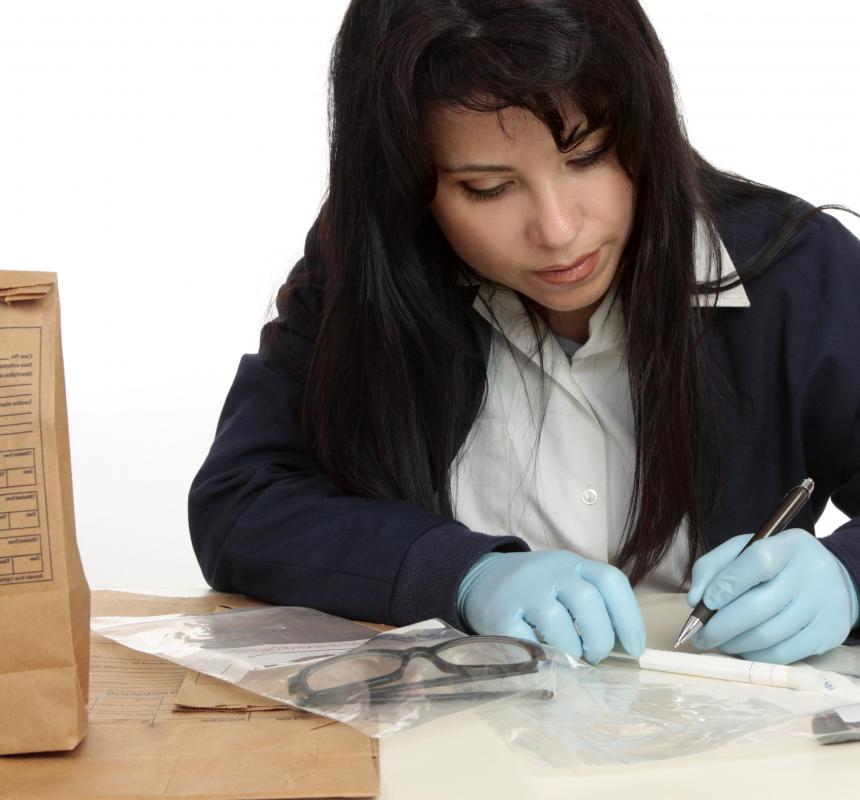At WiseGEEK, we're committed to delivering accurate, trustworthy information. Our expert-authored content is rigorously fact-checked and sourced from credible authorities. Discover how we uphold the highest standards in providing you with reliable knowledge.
What Is Trace Evidence?
Trace evidence usually consists of particles, mostly microscopic, left on a crime scene by a perpetrator. The examination of trace evidence by forensic specialists often assists in identifying the source of a crime, a suspect, or a victim. Most people unknowingly leave trace evidence on the scene of a crime, and it is often difficult to remove. There are various forms of minute evidence that forensic teams use to corroborate additional findings. It is rare this type of evidence is used alone to support a case in a court of law.
Hairs and fibers can be key factors in identifying a suspect or victim, and are often transferred between the two. There are a multitude of elements of hair that can help forensic engineers during the identification process. Fibers are important because they can be transferred from vehicles, clothing, carpeting, and other fabric-based sources to the crime scene, or can be extracted from the scene and be found on a suspect. This portion of trace evidence can narrow down a search based on already known facts.

Forensic teams use a complex system to determine needed information from this evidence to narrow down the unknowns and support other discoveries. Paint and dirt are also vital discoveries on a crime scene. Forensic science can determine the make and model of a car used to commit a crime or the type of paint from a crime scene could be discovered on a suspect's possessions. Dirt also leaves an imprint on a crime scene, and can be analyzed to determine where a suspect may live, work, or where he or she was prior to the crime.

The most essential category of trace evidence is biological, especially fluids and blood. Fluids can include sweat, semen, and saliva, which are often analyzed to identify deoxyribonucleic acid (DNA) and matched with a suspect's genetic code. Aside from its DNA importance, blood is highly valuable in recreating a crime scene and determining the time the act took place. Forensic photography is used to capture blood splatter patterns, which allows detectives to visualize the specifics of a crime.

Edmond Locard, who studied and experimented with forensic law in the early 1900s, proved that there was an exchange of evidence during a crime. This theory became Locard's Exchange Principle, which is the basis for trace evidence and other forensic discoveries. The microscopic details found during a criminal investigation usually help tie the larger evidence together and give additional insight into the behavior and identity of a suspect.
AS FEATURED ON:
AS FEATURED ON:

















Discussion Comments
What's fun to see is how much he concept of trace evidence has captured the public imagination. Actually, that has always been the case. There was a reason that dashing detective was often pictured with a magnifying glass. That character was looking for evidence that couldn't be seen with the naked eye and the "detective with magnifying glass" icon has been common for a couple of centuries now in detective fiction.
Of course, the notion of using trace evidence to catch criminals has made for some great television. Both police procedure shows and science fiction programs use the concept frequently.
That is precisely why it is much more difficult to get away with crimes than it was in the past. Forensic sciences have developed to the point where even a microscopic bit of evidence might be enough to convict someone.
Years ago, law enforcement didn't have the technology to collect and analyze evidence like it does now. For those looking for a career path, something in forensics is clearly a growth area.
Post your comments